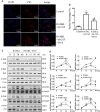Muscone Ameliorates Ovariectomy-Induced Bone Loss and Receptor Activator of Nuclear Factor-κb Ligand-Induced Osteoclastogenesis by Suppressing TNF Receptor-Associated Factor 6-Mediated Signaling Pathways
- PMID: 32265718
- PMCID: PMC7099619
- DOI: 10.3389/fphar.2020.00348
Muscone Ameliorates Ovariectomy-Induced Bone Loss and Receptor Activator of Nuclear Factor-κb Ligand-Induced Osteoclastogenesis by Suppressing TNF Receptor-Associated Factor 6-Mediated Signaling Pathways
Abstract
Postmenopausal osteoporosis is caused by the deficiency of estrogen, which breaks bone homeostasis and induces levels of pro-inflammatory cytokines. Muscone is a potent anti-inflammatory agent and is used to treat bone fracture in traditional Chinese medicine. However, its anti-osteoclastogenic effects remain unclear. For in vitro study, morphology tests of osteoclastogenesis were firstly performed. And then, factors in RANK-induced NF-κB and MAPK pathways were examined by RT-PCR and Western blot, and the binding of TNF receptor-associated factor (TRAF)6 to RANK was inspected by coimmunoprecipitation and immunofluorescence staining. For in vivo experiments, C57BL/6 ovariectomized (OVX) mice were used for detection, including H&E staining, TRAP staining, and micro CT. As a result, muscone reduced OVX-induced bone loss in mice and osteoclast differentiation in vitro, by inhibiting TRAF6 binding to RANK, and then suppressed NF-κB and MAPK signaling pathways. The expression of the downstream biomarkers was finally inhibited, including NFATc1, CTR, TRAP, cathepsin K, and MMP-9. The inflammatory factors, TNF-a and IL-6, were also reduced by muscone. Taken together, muscone inhibited the binding of TRAF6 to RANK induced by RANKL, thus blocking NF-kB and MAPK pathways, and down-regulating related gene expression. Finally, muscone inhibited osteoclastogenesis and osteoclast function by blocking RANK-TRAF6 binding, as well as downstream signaling pathways in vitro. Muscone also reduced ovariectomy-induced bone loss in vivo.
Keywords: RANK; TRAF6; muscone; osteoclasts; postmenopausal osteoporosis.
Copyright © 2020 Zhai, Yan, Zhao, Chen, Yang, Cai, He, Huang, Li, Yang, Zhou, Zhao, Wei, Bai and Li.
Figures








Similar articles
-
Shikimic Acid Inhibits Osteoclastogenesis in Vivo and in Vitro by Blocking RANK/TRAF6 Association and Suppressing NF-κB and MAPK Signaling Pathways.Cell Physiol Biochem. 2018;51(6):2858-2871. doi: 10.1159/000496039. Epub 2018 Dec 14. Cell Physiol Biochem. 2018. PMID: 30562759
-
Maslinic acid suppresses osteoclastogenesis and prevents ovariectomy-induced bone loss by regulating RANKL-mediated NF-κB and MAPK signaling pathways.J Bone Miner Res. 2011 Mar;26(3):644-56. doi: 10.1002/jbmr.242. J Bone Miner Res. 2011. PMID: 20814972
-
Rosavin suppresses osteoclastogenesis in vivo and in vitro by blocking the nuclear factor kappa-light-chain-enhancer of activated B cells (NF-κB) and mitogen-activated protein kinase (MAPK) signaling pathways.Ann Transl Med. 2021 Mar;9(5):383. doi: 10.21037/atm-20-4255. Ann Transl Med. 2021. PMID: 33842604 Free PMC article.
-
Leonurine hydrochloride inhibits osteoclastogenesis and prevents osteoporosis associated with estrogen deficiency by inhibiting the NF-κB and PI3K/Akt signaling pathways.Bone. 2015 Jun;75:128-37. doi: 10.1016/j.bone.2015.02.017. Epub 2015 Feb 21. Bone. 2015. PMID: 25708053
-
Anti-Osteoporotic Mechanisms of Polyphenols Elucidated Based on In Vivo Studies Using Ovariectomized Animals.Antioxidants (Basel). 2022 Jan 23;11(2):217. doi: 10.3390/antiox11020217. Antioxidants (Basel). 2022. PMID: 35204100 Free PMC article. Review.
Cited by
-
Classic mechanisms and experimental models for the anti-inflammatory effect of traditional Chinese medicine.Animal Model Exp Med. 2022 Apr;5(2):108-119. doi: 10.1002/ame2.12224. Epub 2022 Apr 12. Animal Model Exp Med. 2022. PMID: 35412027 Free PMC article. Review.
-
TNF receptor-associated factors: promising targets of natural products for the treatment of osteoporosis.Front Physiol. 2025 May 27;16:1527814. doi: 10.3389/fphys.2025.1527814. eCollection 2025. Front Physiol. 2025. PMID: 40496246 Free PMC article. Review.
-
Alleviation of dextran sulfate sodium (DSS)-induced colitis in mice through the antioxidative effects of muscone via the MyD88/p38 MAPK signalling pathway.PeerJ. 2025 May 28;13:e19397. doi: 10.7717/peerj.19397. eCollection 2025. PeerJ. 2025. PMID: 40452925 Free PMC article.
-
Effect of combined intervention of exercise and autologous bone marrow stromal cell transplantation on neurotrophic factors and pain-related cascades over time after sciatic nerve injury.J Exerc Rehabil. 2023 Feb 23;19(1):19-26. doi: 10.12965/jer.2244006.003. eCollection 2023 Feb. J Exerc Rehabil. 2023. PMID: 36910683 Free PMC article.
-
A network pharmacology approach to explore and validate the potential targets of ginsenoside on osteoporosis.Int J Immunopathol Pharmacol. 2022 Jan-Dec;36:3946320221107239. doi: 10.1177/03946320221107239. Int J Immunopathol Pharmacol. 2022. PMID: 35791093 Free PMC article.
References
LinkOut - more resources
Full Text Sources
Research Materials
Miscellaneous

